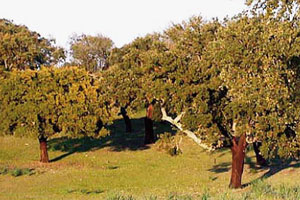It is found in the Mediterranean basin of southern Europe and in northen Africa, in the western zone of North America (California), in the southern part of South America (in Chile, from the region of Bíobío) and in Australia. The predominant climate in this kind of forest is Mediterranean, with cold winters and hot and dry summers, with little rainfall.
Perennial trees and bushes with small leaves and often covered with tiny hairs to prevent the loss of water are abundant. The dominant species are the Holm Oak (Quercus ilex), the Cork Oak (Quercus suber) and the Portuguese Oak (Quercus faginea). He undergrowth is woody, thorny and aromatic, with evergreen leaved species like the Mastic (Pistacia lentiscus), Rosemary (Rosmarinus officinalis), and Thyme (Thymus vulgaris), among others.
The fauna is varied and migratory birds, reptiles and small mammals like rodents, rabbits and hares abound, which support a community of predators made up of great sized mammals, like foxes, lynxes, and birds of prey, like kites, kestrels and the Imperial Eagle (Aquila adalberti).
Sclerophyll forest
Also known as evergreen forest, it is present in the central zone of Chile, from the region of Coquimbo to the region of Biobío. It is made up of trees and bushes with tough leaves that are resistant to great changes in temperature and humidity. The climate is Mediterranean and is characterized for having rainy winters and dry summers.
The main species of this forest are the Espino (Acacia caven), the Soapbark (Quillaja saponaria), the Mayten (Maytenus boaria), the Litre (Lithraea caustica), the Peumo (Cryptocarya alba), the Boldo (Peumus boldus), the Olivillo (Aextoxicon punctatum), the Belloto (Beilschmedia berteroana), the Myrtle (Luma apiculata), the Colliguay (Colliguaya odorifera), the Maqui (Aristotelia maqui), the Blue Puya (Puya berteroniana), among others.
Several species of bird have been identified within this forest, such as thrushes, diuca finches, Chilean mockingbirds, hummingbirds, tufted tit-tyrants, long-tailed meadowlarks, house wrens, southern lapwings, mustached turcas and Chilean flickers. Among the birds of prey the most common are eagles, harriers, kestrels and caracaras. Some mammals may also be found, like the South American Red Fox (Dusicyon culpaeus), the Lesser Grison (Galictis cuja), the Molina’s Hog-Nosed Skunk (Conepatus chinga) and the Mouse Opossum (Marmosa elegans) and some native rodents, like the Degu (Octodon degus) and the Coruro (Spalacopus cyanus). In addition, reptiles are bserved, among which one can find the Long-Tailed Snake (Philodryas chamissonis) and several lizards of the gender Liolaemus.
In recent times, this type of forest has decreased its vegetation drastically, as Man has exploited it and set it on fire in order to clear land and use it for farming and cattle.








 Muere Evita
Muere Evita